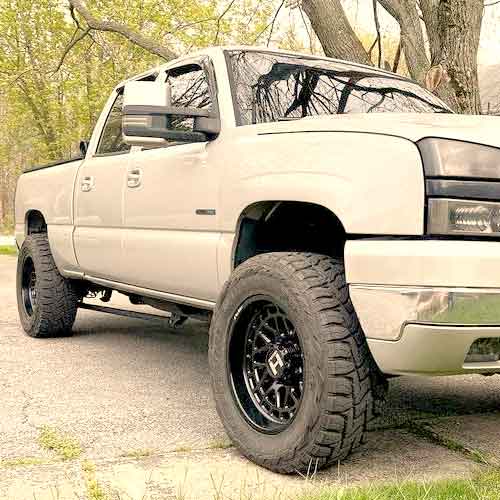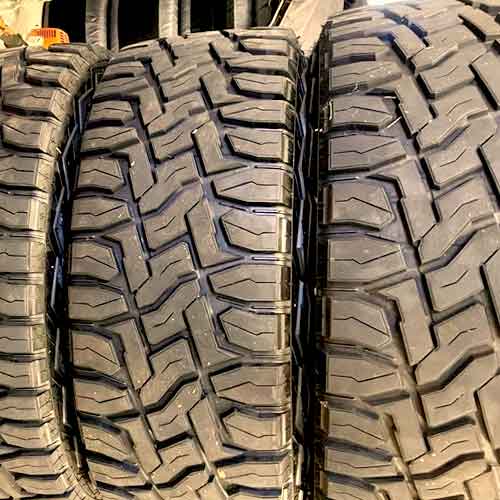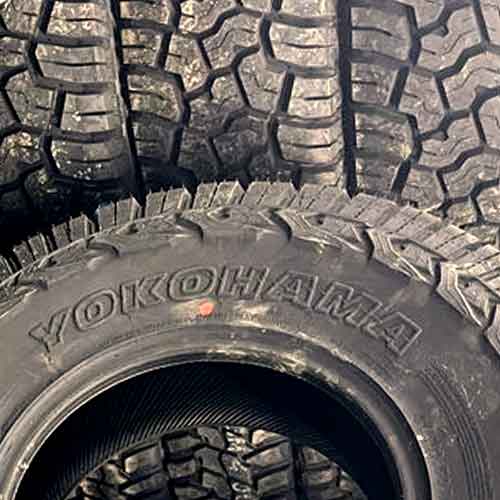The Yokohama Geolandar X-AT and the Toyo Open Country RT are rugged terrain tires (also called hybrids), which can handle anything from muddy trails to smooth pavement. Though they are not as comfy as the All-terrain tires due to their aggressiveness.

In my expert opinion as a tire engineer, the Toyo R/T yields a better commercial traction comparatively. The tire has biters better on rocks with bigger groove mouth, and it’s self cleaning tread is sustained more on muddy tracks. But that does not mean it’s highway capability is compromised, as it offers superior dry grip there as well, though its wet traction can be improved, and that’s where Yokohama Geolandar X-AT comes in. This tire is basically better optimized for all season traction, so you also get far superior traction on snowy terrains, earning the tire with 3 Peak Mountain Snowflake rating unlike the Toyo R/T.
Review Yokohama X-A/T in detail: https://tiredriver.com/yokohama-geolandar-x-at-g016-review/
Review Toyo’s boy in detail: https://tiredriver.com/review-of-toyo-open-country-rt/
Available Sizes
Starting with Toyo R/T the tire comes in 15 to 24 inches having following specs:
- Speed Ratings: T & Q.
- Load Range: SL, XL, C to F.
- Weight Range: 43 to 100 lbs.
- Tread Depth Range: 13 to 19/32″ (most sizes have 19/32″).
- 45K miles warranty.
- No 3PMSF rating is available.
On the other side, the Yokohama Geolandar X-AT has sizes with 15 to 22 inches.
- They have speed ratings available of only Q.
- Load ratings: C to F.
- Weight Range: 40 to 83 lbs.
- Tread depth: 16 to 19/32″.
- Warranty: 45k miles for all sizes.
- 3PMSF/M+S Ratings Available.
Durability
Off-road tires must be able to withstand harsh terrain and sharp objects, making durability a crucial factor.
And as sidewalls have the least layers of plies (form underneath), they are particularly more susceptible to damage. But in case of these tires here, they are very much protected.
As both tires offer 3 ply polyester sides. Though the Yokohama X-AT is slightly weaker form the middle with just a single cap ply, whereas Toyo R/T offers 2 ply nylon (with similar thickness of tread on top).
Tread Features
Starting things off with Toyo Open Country RT, the tire offers a rugged (hybrid design).

Starting from the middle, here you see 2 L shaped lugs forming very sharp edges towards sides.
These are equipped with less tread features and siping, which limits its wet grip, due to reinforced foundations under all of these blocks, its dry rods stability is superior.
Towards sides, same story goes, there are 2 unique shoulder lugs which vary in shapes slightly but have similar full depth siping.
These sipes here are although better compared to middle, they are still not that effective (explained why, in the wet traction section below).
The outer margins of the these lugs are staggered though and they form bigger mud scoops in comparison.
And if you consider the sidewall lugs, they are also very biting off road.
The Yokohama Geolandar X-AT also being a hybrid has a mixture of mud and all-terrain tread features, where shoulder lugs get to be more open compared to central part of the tire.

The lugs are staggered and make powerful biters on sidewalls that help with providing extra foot print with lowered air pressure (off-road).
The shoulder lugs towards sides make thick slits, optimized for winter traction, whereas towards middle they convert to siping which deals with water.
The middle section is separated by prominent longitudinal grooves of rugged pattern.
Here L and S shaped ribs are seen, and they are equipped with notches and full depth sipes (of similar pattern).
4 of these ribs combined make a straight-forward lateral grooves that connect the outer, more open voids of the shoulder lugs, resulting in a self-cleaning tread.
Which reminds me, the shoulder lugs have stone ejectors in all directions, so it further aids in removing any dirt off the tread fast.
Dry Traction
The tire’s contact patch, or footprint, is a key factor in determining grip. And when we consider simply the grip, to be more specific, directional grip (measure with stopping distances), the middle area of thread is judged along-with tread composition and structure.
Now out of both tires, the Toyo R/T offers shorter braking distances (better grip), with it’s more stable lugs.
Although the footprint of both tires have equal surface area connecting with the road, the Yokohama X A/T has more flexing lugs as it offers a softer rubber composition.
Because of this the small blocks (left unsupported) become sloppy and can’t not grip in a better way.
Similarly the tire’s handling is also compromised which has to do with shoulder lugs. As the tire turns, a lot of the energy is wasted in to flexing those lugs, and so along with longer handling times, the steering feedback is also affected negatively.
That’s why the tire has limited speed ratings up to Q, whereas, Toyo Open Country R/T offers up to T where you can reach up to 118 mph.
Learn more about speed ratings.
Wet Traction
Wet traction is a little different, and here flexible tread is actually better, as it allows faster water removal which enhances grip and hydroplaning resistance, the two main parts of it.
Let’s discuss them both.
Wet Grip
For wet grip, siping is very important. You need more number of these sipes, and they have to be effective.
Sipes basically suck in the water particles by expanding and contracting, so their flexibility is also important here.
So, with more siping, and a flexible design, Yokohama Geolandar X-AT offers better results.
Toyo Open Country RT has a stiffer build of rubber and if you consider it’s tread again (in tread section above), you’ll notice how limited are the sipes there.
Though it’s better in another area of traction.
Hydroplaning
Hydroplaning can be prevented by ensuring that a tire has sufficient grooves to effectively evacuate water from its tread.
These grooves help the tire maintain contact with the road surface, even when moving through standing water at higher speeds.
Both these tires here being in the hybrid terrain category offer a pretty bald design which allow easy water removal in all directions (with their interconnected tread voids).
Traction on Rugged Terrains
Hybrid tires like these should be able to handle rough terrains and have strong self-cleaning abilities to perform well on various terrain types.
So let see how well they performed on all of them. Starting with the toughest terrains of all.
Muddy Tracks
Mud is very challenging, that’s why we have mud-terrain tires named after them.
Here the balder the tire, the better, as you can’t survive on this terrain with out proper mud evacuation.
Out of both, the Yokohama X AT offers better self cleaning grooves, though both tires are pretty voided.
This is because the Toyo R/T has an interlocking design with it’s L shaped lugs surrounding each other, and this makes it slightly difficult for mud to leave out easily (in comparison).
On Rocks
Both tires are pretty great on rocks but here the Toyo R/T offers better lateral traction, whereas Yokohama X AT is great at directional.
The Geolandar X AT grips better in from the middle with it’s flexible tread and smaller lugs. It’s light weight also helps during climb.
But the tire does not offers aggressive enough shoulders, and it’s sidewalls have skinnier lugs in comparison, and that’s where Toyo R/T comes in.
Desert Performance
With sharper sides, the Toyo Open Country R/T is not able to keep up on sand, especially on deeper terrains.
That’s because the tire weighs above 100 pounds, and it’s sharp staggered lugs want to dig in, instead of going forward, and this is really felt while climbing on sandy slopes, on hills for example.
The Yokohama X AT is softer overall, and its edges are smoother comparatively so it provides better efficacy on this terrain.
Fuel Usage and Tread Wear
The fuel consumption of a tire is directly linked to its rolling resistance, which depends highly on weight and tread’s composition.
Both tires offers very similar fuel consumption, as they are not “efficient” here by any means, but they contribute to rolling resistance differently.
The Toyo R/T consumes more fuel because of it’s greater weight, whereas the Yokohama X A/T is equally as good, or should I say bad, with it’s stickier composition.
But with softer design the tire get to wear faster, and since both tires have similar tread depth range, it makes Toyo R/T better with overall tread life.
Ride Quality
The overall comfort of the ride though has to do with the feel of suspension, it also highly depends on noise.
Noise is generated by air particles hitting the tread, and with such wider grooves both these tires provide a lot of room for air to move around every which way.
Yet still, Toyo Open Country RT provides you with a more silent ride in comparison, as it yields better pitch sequencing. With it the noise hitting on lugs create different tones, and don’t sync up together, and noise is dampened that way.
The Geolandar X AT on the other hand, also tries to minimize noise in a similar way, but it’s groove resonance is simply too high (in other words, you can say, noise reflects off the tread more in this tire).
Though the tire is better in providing a comfortable ride due to it’s superior bumps cushioning ability. It’s softer compound combined with thick rubber layer (19/32″ in tread depth) offers a lot of room for vibrations to settle down, while its spongy rubber soak in the bumps to enhance comfort.
Winter Capability
The performance of a tire in snowy conditions is evaluated based on its ability to provide stability while stopping, maintain control during turns, and accelerate effectively on both shallow and deep snow, as well as ice.
For on-road snow, the tires which have at least 10% better acceleration values compared to average all-season tires get to have 3 peak mountain snowflake rating.
Both these tires although don’t offer this rating, the Yokohama X AT offers a better traction in comparison still as it features sipes especially designed for snow.
It’s shoulder lugs for example, have thick full depth slits on edges, and these grab and trap in the snow particles, providing snow to snow contact. (For winter traction, you need that, instead of rubber to snow contact).
Summarizing
Both are rugged terrain tires with mud terrain shoulder lugs, yet the Yokohama Geolandar X-AT offers better mud and sand traction.
And on highways, the tire is better in wet traction, fuel consumption, comfort and snow traction.
On the other side, the Toyo Open Country R/T provides better dry grip, tread life, and noise dampening.